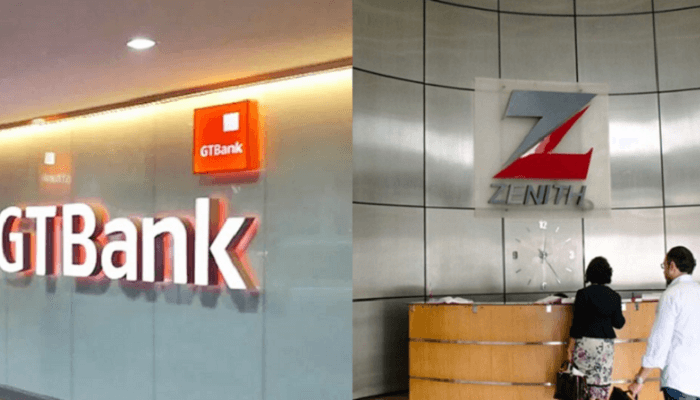Nigeria has cemented its dominance in Africa’s banking landscape, with Guaranty Trust Bank (GTB), Zenith Bank, and United Bank for Africa (UBA) emerging among the top five institutions in The Africa Report’s 2025 ranking of the Top 300 Finance Champions on the continent.
The ranking, which evaluates the performance of Africa’s largest consolidated banking groups based on profitability, solvency, liquidity, credit quality, and total assets, placed GTB at number one, followed by Zenith Bank and UBA, which took the third and fifth positions, respectively. Access Bank (#9) and First Bank of Nigeria (#12) also made the top tier, giving Nigeria four lenders in the top ten, more than any other country in Africa.
“Driving the growth of Africa’s top-performing consolidated groups are Nigerian banks,” The Africa Report said, noting that GTB retained its top spot for the second consecutive year.
In August 2025, Guaranty Trust Holding Company, led by Segun Agbaje, the company’s CEO, injected N365.9 billion ($238.5 million) into its banking arm through a capital increase, raising its share capital above N504 billion and meeting the Central Bank of Nigeria’s new N500 billion minimum capital requirement.
The group also made history by listing on the London Stock Exchange’s secondary market, becoming the first West African financial institution to do so, in other to attract major international investors and accelerate its continental footprint.
“Capital rules are tightening, risks remain elevated,” said Tim Slater, director at Fitch Ratings, in an interview with The Africa Report.
“In francophone West Africa, the exit of French banks and associated shift toward local ownership and regional champions is creating new growth opportunities.”
For Nigeria, high domestic interest rates and strong deposit bases have been key advantages. The Central Bank’s 27.5 percent policy rate since February 2025 widened banks’ net interest margins, while deposits averaging 10–11 percent offered cheap funding at scale.
“Thus, performance has been largely shaped by domestic macroeconomic and regulatory conditions,” explained Damilare Asimiyu, macroeconomic strategist at Afrinvest (West Africa).
“The tight monetary stance, improved financial inclusion [up to 78 percent in 2024 from 63 percent in 2022], and the rapid adoption of digital channels have underpinned stronger balance sheets, higher profitability, and improved investor sentiment.”
Zenith Bank’s executive director, Henry Oroh, said the bank continues to prioritise prudence even as it expands across new markets. “We don’t want to make money at all costs,” Oroh said. “We’d rather lose the money, lose the business, than lose our capital.”
Read also: Zenith, GTCO lead banks in gender policy compliance
Kenya: credit strain weighs on performance
While Kenya’s largest lenders, Kenya Commercial Bank (KCB) and Equity Group, remained among the top 20, high non-performing loans (NPLs) and economic slowdown limited their rise.
Kenya’s economy grew 4.7 percent in 2024, slower than the 5.7 percent recorded the previous year, while the average NPL ratio hit 16.4 percent, more than double the continental average of 7.3 percent.
“The credit profiles of Kenyan banks, especially the large ones, are considered quite resilient,” said Tim Slater of Fitch Ratings. “These banks have strong revenue generation, which provides a substantial buffer to absorb loan impairment charges.”
South Africa: sophisticated but sluggish
South Africa’s “Big Four”—Standard Bank (#7), FirstRand (#15), Nedbank (#18), and Absa (#23)—remain among the continent’s largest but have “lost relative ground compared with their Nigerian and Egyptian rivals,” according to the report.
Persistent load-shedding, high unemployment, and sluggish growth have constrained bank lending, yet analysts highlight their superior governance frameworks.
“South African banks are among the most sophisticated on the continent and are thus very strong in terms of risk management,” said Mik Kabeya, vice president and senior credit officer at Moody’s Ratings.
Egypt: balance-sheet strength and foreign inflows
Egypt’s banking sector continues to benefit from structural reforms and foreign capital inflows, with Commercial International Bank (#2), National Bank of Egypt (#4), and Banque Misr (#6) leading the country’s representation in the top 10.
“A steady flow of foreign direct investment, particularly from the UAE, has further supported the economy and thus the operating environment,” the report noted. Egyptian banks, it added, owe their lofty positions to “sheer balance sheet heft” and dominance in the domestic retail market.
Francophone Africa: resilience amid reforms
Morocco’s Attijariwafa Bank (#19), BMCE Bank of Africa (#24), and Banque Centrale Populaire (#25) held steady, but many West and Central African institutions were hit by tougher regulations.
Banks in the West African Economic and Monetary Union (WAEMU) and CEMAC zones had to double their minimum share capital requirements, from CFA 10 billion to CFA 20 billion, straining liquidity.
Meanwhile, Ecobank (#11) faces a leadership transition following Nedbank’s exit as its largest shareholder and the entry of financier Alain Nkontchou. “The group needs a shareholder capable of injecting capital over time to seize growth opportunities,” Jeremy Awori, CEO of Ecobank, told The Africa Report.

